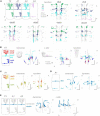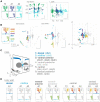Distinctive features of the central synaptic organization of Drosophila larval proprioceptors
- PMID: 37564629
- PMCID: PMC10410283
- DOI: 10.3389/fncir.2023.1223334
Distinctive features of the central synaptic organization of Drosophila larval proprioceptors
Abstract
Proprioceptive feedback is critically needed for locomotor control, but how this information is incorporated into central proprioceptive processing circuits remains poorly understood. Circuit organization emerges from the spatial distribution of synaptic connections between neurons. This distribution is difficult to discern in model systems where only a few cells can be probed simultaneously. Therefore, we turned to a relatively simple and accessible nervous system to ask: how are proprioceptors' input and output synapses organized in space, and what principles underlie this organization? Using the Drosophila larval connectome, we generated a map of the input and output synapses of 34 proprioceptors in several adjacent body segments (5-6 left-right pairs per segment). We characterized the spatial organization of these synapses, and compared this organization to that of other somatosensory neurons' synapses. We found three distinguishing features of larval proprioceptor synapses: (1) Generally, individual proprioceptor types display segmental somatotopy. (2) Proprioceptor output synapses both converge and diverge in space; they are organized into six spatial domains, each containing a unique set of one or more proprioceptors. Proprioceptors form output synapses along the proximal axonal entry pathway into the neuropil. (3) Proprioceptors receive few inhibitory input synapses. Further, we find that these three features do not apply to other larval somatosensory neurons. Thus, we have generated the most comprehensive map to date of how proprioceptor synapses are centrally organized. This map documents previously undescribed features of proprioceptors, raises questions about underlying developmental mechanisms, and has implications for downstream proprioceptive processing circuits.
Keywords: connectome; nociception; proprioception; somatosensation; synapses.
Copyright © 2023 Greaney, Wreden and Heckscher.
Conflict of interest statement
The authors declare that the research was conducted in the absence of any commercial or financial relationships that could be construed as a potential conflict of interest.
Figures







Similar articles
-
Biomechanical origins of proprioceptor feature selectivity and topographic maps in the Drosophila leg.Neuron. 2023 Oct 18;111(20):3230-3243.e14. doi: 10.1016/j.neuron.2023.07.009. Epub 2023 Aug 9. Neuron. 2023. PMID: 37562405 Free PMC article.
-
Synaptic interactions between a muscle-associated proprioceptor and body wall muscle motor neurons in larval and Adult manduca sexta.J Neurophysiol. 1996 Sep;76(3):1597-610. doi: 10.1152/jn.1996.76.3.1597. J Neurophysiol. 1996. PMID: 8890279
-
Neural Coding of Leg Proprioception in Drosophila.Neuron. 2018 Nov 7;100(3):636-650.e6. doi: 10.1016/j.neuron.2018.09.009. Epub 2018 Oct 4. Neuron. 2018. PMID: 30293823 Free PMC article.
-
Proprioception, the regulator of motor function.BMB Rep. 2021 Aug;54(8):393-402. doi: 10.5483/BMBRep.2021.54.8.052. BMB Rep. 2021. PMID: 34078529 Free PMC article. Review.
-
Making Feeding Decisions in the Drosophila Nervous System.Curr Biol. 2020 Jul 20;30(14):R831-R840. doi: 10.1016/j.cub.2020.06.036. Curr Biol. 2020. PMID: 32693083 Review.
References
Publication types
MeSH terms
Grants and funding
LinkOut - more resources
Full Text Sources
Molecular Biology Databases

